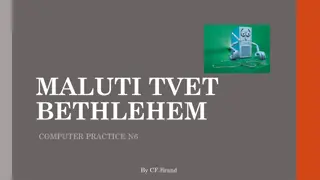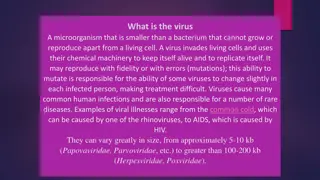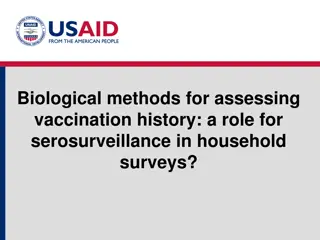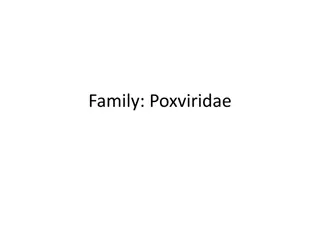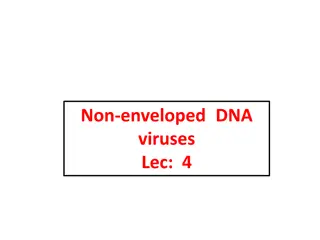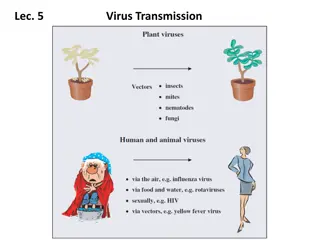
Clinical Virology Case Studies with Derrick Chen, MD
Dive into clinical virology case studies with Derrick Chen, MD, an Associate Professor at the Univ. of Wisconsin Madison. Explore viral infections diagnosed serologically, excluding HIV and hepatitis viruses.
Download Presentation

Please find below an Image/Link to download the presentation.
The content on the website is provided AS IS for your information and personal use only. It may not be sold, licensed, or shared on other websites without obtaining consent from the author. If you encounter any issues during the download, it is possible that the publisher has removed the file from their server.
You are allowed to download the files provided on this website for personal or commercial use, subject to the condition that they are used lawfully. All files are the property of their respective owners.
The content on the website is provided AS IS for your information and personal use only. It may not be sold, licensed, or shared on other websites without obtaining consent from the author.
E N D
Presentation Transcript
Clinical Virology Case Studies Derrick Chen, MD Associate Professor, Dept of Pathology and Lab Medicine, Univ of Wisconsin Madison Medical Director, Clinical Microbiology, UW Health
Disclosures No relevant conflicts of interest
Case Selection Criteria Viral infections that are optimally diagnosed using serological, rather than molecular, methods Excluding HIV and hepatitis viruses
Case Selection Criteria Viral infections that are optimally diagnosed using serological, rather than molecular, methods Excluding HIV and hepatitis viruses
Case Selection Criteria Based on the selection criteria, your thoughts are:
Case Selection Criteria Based on the selection criteria, your thoughts are: a. Serological diagnosis and not HIV or hepatitis? What s left to talk about?
Case Selection Criteria Based on the selection criteria, your thoughts are: a. Serological diagnosis and not HIV or hepatitis? What s left to talk about? b. Fine. Maybe there s something to talk about, but for 30+ minutes?
Case Selection Criteria Based on the selection criteria, your thoughts are: a. Serological diagnosis and not HIV or hepatitis? What s left to talk about? b. Fine. Maybe there s something to talk about, but for 30+ minutes? c. C , I always pick C .
Case Selection Criteria Based on the selection criteria, your thoughts are: a. Serological diagnosis and not HIV or hepatitis? What s left to talk about? b. Fine. Maybe there s something to talk about, but for 30+ minutes? c. C , I always pick C . d. Why don t we have the trainees answer first?
Case Selection Criteria Based on the selection criteria, your thoughts are: a. Serological diagnosis and not HIV or hepatitis? What s left to talk about? b. Fine. Maybe there s something to talk about, but for 30+ minutes? c. C , I always pick C . d. Why don t we have the trainees answer first? e. Let s give this guy a chance. I m ready to learn!
Case 1 HPI 19F presents to urgent care due to sore throat Started 5 days ago, difficulty swallowing, some fatigue, tried Advil and throat lozenges Also complains of left ear pressure and pain Best friend recently had similar symptoms and had a positive mono test PMHx Nothing significant, no meds, single, never smoked
Case 1 PE BP: 102/66, P: 80, RR: 18, T: 97.8F General: NAD, AAOx3 Left ear: cerumen, eardrum WNL Throat: erythema Mouth: no lesions Pulm: normal breath sounds, no dyspnea Skin: no rash Other: unremarkable
Case 1 Labs Strep A Ag SARS-CoV-2/Influenza A/B PCR Patient counseled, sent home, awaiting test results for any specific treatment
Case 1 HPI Presented to emergency room with worsening sore throat Now difficulty tolerating liquids and solids due to pain, and muffled voice Sexually active including oral sex, no history of STIs for patient or partner No: fever, headache, dizziness, chest pain, dyspnea, abdominal pain, nausea, urinary symptoms
Case 1 PE BP: 134/82, P: 107, RR: 16, T: 100.9, O2: 98% General: NAD, AAOx4 HEENT: edematous and erythematous tonsils bilaterally, white exudate over tonsils and soft palate, TM clear bilaterally Neck: tender cervical LAD, full range of motion CV: RRR, no murmur Pulm: clear, no dyspnea Abdomen: soft, non-distended, non-tender Skin: no rashes or edema
Case 1 Labs Previous Strep A Ag, SARS-CoV-2, Influenza A/B: negative DDX Strep pharyngitis, viral pharyngitis, mononucleosis, meningitis, peritonsillar abscess, retropharyngeal abscess, otitis media Most likely mono, given acetaminophen, dexamethasone, and First Mouthwash BLM New labs:
Case 1 Labs Previous Strep A Ag, SARS-CoV-2, Influenza A/B: negative DDX Strep pharyngitis, viral pharyngitis, mononucleosis, meningitis, peritonsillar abscess, retropharyngeal abscess, otitis media Most likely mono, given acetaminophen, dexamethasone, and First Mouthwash BLM New labs: mono test (positive), Ct/Ng by TMA (negative)
Infectious Mononucleosis Symptoms: fever, pharyngitis, adenopathy, splenomegaly, fatigue, atypical lymphocytosis Rarely: peritonsillar abscess, airway occlusion, splenic rupture Alice-in-Wonderland syndrome in children: distortions of visual perception, body image, and experience of time DDX: GAS, Arcanobacterium, CMV, acute HIV, toxoplasmosis, HHV- 6, HHV-7 Treatment: supportive care (acetaminophen/NSAIDs, fluids, nutrition, rest), corticosteroids for impending airway obstruction
Infectious Mononucleosis Heterophile antibodies: immunoassay to detect heterophile antibodies (target unrelated antigens such as sheep and horse RBCs) Pregnancy (since CMV, HIV, toxo may have adverse effects), help inform patients of risks (splenic rupture, airway obstruction, prolonged fatigue) May be false negative in early infection (25% FN first week), can take over 3 months, can repeat test or order EBV-specific Ab Often negative (~50%) in children <4 yo Can rarely (2-3%) persist >1 year, resulting in false positives False positives: leukemia/lymphoma, CMV, RA, adenovirus, viral hepatitis, toxoplasma
Infectious Mononucleosis Heterophile antibodies: immunoassay to detect heterophile antibodies (target unrelated antigens such as sheep and horse RBCs) Pregnancy (since CMV, HIV, toxo may have adverse effects), help inform patients of risks (splenic rupture, airway obstruction, prolonged fatigue) May be false negative in early infection (25% FN first week), can take over 3 months, can repeat test or order EBV-specific Ab Often negative (~50%) in children <4 yo Can rarely (2-3%) persist >1 year, resulting in false positives False positives: leukemia/lymphoma, CMV, RA, adenovirus, viral hepatitis, toxoplasma EBV-specific antibodies: Gold standard for IM, high sensitivity and specificity VCA IgM can be false positive with other herpes viruses (e.g. CMV) May be present due to reactivation vs acute infection
Infectious Mononucleosis Heterophile antibodies: immunoassay to detect heterophile antibodies (target unrelated antigens such as sheep and horse RBCs) Pregnancy (since CMV, HIV, toxo may have adverse effects), help inform patients of risks (splenic rupture, airway obstruction, prolonged fatigue) May be false negative in early infection (25% FN first week), can take over 3 months, can repeat test or order EBV-specific Ab Often negative (~50%) in children <4 yo Can rarely (2-3%) persist >1 year, resulting in false positives False positives: leukemia/lymphoma, CMV, RA, adenovirus, viral hepatitis, toxoplasma EBV-specific antibodies: Gold standard for IM, high sensitivity and specificity VCA IgM can be false positive with other herpes viruses (e.g. CMV) May be present due to reactivation vs acute infection NAAT: often negative in acute IM and doesn t direct therapy; used for transplant recipients for EBV-related lymphoproliferative disorders
Case 2: hypotonia Girl with ponytails silhouette clipart, toddler, full body illustration psd
Case 2 HPI 7F hx prematurity, genetic seizure syndrome, hydrocephalus with VP shunt, spastic quadriplegic cerebral palsy Presented to emergency room with 1 day of altered mental status, fever, extreme lethargy, low tone, apnea, cough, and not urinating Seen at OSH earlier in the day: elevated LFTs, thrombocytopenia (thought to be due to antiepileptics), elevated CRP, mildly elevated procalcitonin, COVID/Flu/RSV PCR negative, UA unremarkable, blood cultures drawn, CXR no infiltrates or consolidations Was hospitalized >1 month ago: E. coli UTI and RVP (+)adenovirus
Case 2 PE BP: 82/55, P: 82 General: somnolent HEENT: dry mucous membranes Pulm: apneic periods > 5 seconds Abd: +BS, NT, ND, no organomegaly but LLQ firm to palpation, G-tube Ext: pulses present, no edema Skin: no rashes, ecchymoses, or abrasions Neuro: does not respond to voice/stimulation, no verbalization, not appear awake or aware; pupils large, reactive to light bilaterally, face symmetric; no movement of arms/legs, hypotonia; no reaction to crude touch in arms/legs; reflexes 1+ throughout, no clonus (which is unusual for patient)
Case 2 DDX Infection, medication toxicity (baclofen, antiepileptics), seizure effects or post ictal state, shunt malfunction, hepatic encephalopathy Most consistent with viral infection
Case 2 Studies Reduce baclofen dosing (did not improve) Free/total carnitine, TSH, fT4, ammonia, clobazam & metabolite, valproate trough (unremarkable) CBC (pancytopenia, ?viral suppression) PT/INR (WNL) RVP (negative) EEG (pattern consistent with known genetic seizure syndrome, no seizures seen) Quickbrain MRI to evaluate shunt (stable slitlike ventricular system, shunt in stable position)
Case 2 Additional studies CMV IgM/IgG antibodies (negative) Hepatitis A IgM antibody (negative) Hepatitis B surface Ag (negative) Hepatitis C antibody (negative)
Case 2 Additional studies CMV IgM/IgG antibodies (negative) Hepatitis A IgM antibody (negative) Hepatitis B surface Ag (negative) Hepatitis C antibody (negative) EBV antibodies (+VCA IgM, -EA IgG, -EBNA IgG) Parvovirus antibodies IgM 30.34 IV (positive is 1.11 IV or greater) IgG 1.21 IV (positive is 1.10 or greater)
Case 2 Clinical Considerations Parvovirus Was noted to have transient rash on cheeks and torso Pancytopenia No polyarthropathy or joint swelling EBV Had diarrhea early on in illness (more likely EBV vs parvovirus)
False-Positive EBV and HSV due to Parvovirus EBV may result in false-positive parvovirus IgM results
False-Positive EBV and HSV due to Parvovirus EBV may result in false-positive parvovirus IgM results Serum collected from 68 patients during parvovirus outbreak in Belgium Diasorin Liaison: 84% (+)EBV IgM; 90% (+)HSV IgM Polyvinylpyrrolidone and polyvinyl alcohol added to dilution buffer partially eliminated assay interference Berth M, Bosmans E. Acute parvovirus B19 infection frequently causes false-positive results in Epstein-Barr virus- and herpes simplex virus-specific immunoglobulin M determinations done on the Liaison platform. Clin Vaccine Immunol . 2009 Mar;16(3):372-5.
Case 3 HPI 40F with myasthenia gravis presented to urgent care due to acute onset arthralgia for 2 days Arthralgias in knees, shoulders, wrists, and hands Whole body aches, stiffness, worse with movement, numbness in fingers woke her while sleeping Had a cold few weeks ago No: vomiting, nausea, tick bites, fever, cold symptoms DDX: unclear, could be viral, started prednisone taper
Case 3 Labs CBC (mild thrombocytosis), BMP (unremarkable), ESR/CRP (WNL) Uric acid (WNL) Ana (1:320 homogeneous) This is a high ANA titer. The homogeneous ANA pattern is usually associated with antibody to histones or DNA. This is consistent with but not specific for SLE. A homogeneous ANA pattern is also seen in other connective tissue diseases, drug-induced LE, sarcoidosis, malignancy, some infections, or aging. Cyclic citrullinated peptide Ab (WNL) Lyme Ab (IA equivocal; immunoblot +IgM/-IgG)
Case 3 Clinical Considerations Unlikely Lyme arthritis Occurs months/years after initial infection, IgG should be positive, usually 1 or few joints, often knee and not usually hands/feet Early disseminated Lyme can cause migratory myalgia/arthralgia but uncharacteristic season (January), and expect +IgM/+IgG immunoblot DDX: prednisone taper helping symptoms, rheumatologic, post viral
Case 3 Additional Labs Patient called wondering if parvovirus was a possible cause since her son had tested positive
Case 3 Additional Labs Patient called wondering if parvovirus was a possible cause since her son had tested positive Parvovirus B19 serology IgM 15.81 IV (positive is 1.11 or greater) IgG 10.50 IV (positive is 1.10 or greater)
Parvovirus B19 Syndromes Erythema infectiosum: children; fever, coryza, headache, nausea, diarrhea, appearance of slapped cheek rash 2-5 days later and then lacelike rash on trunk/extremities days later Arthropathy: adults (esp females); often acute and symmetric, often small joints of hands, wrists, knees, and feet, non-destructive and resolves in 3 wks, can cause +ANA and +RF Transient Systemic Lupus Erythematosus-like Syndrome Associated With Parvovirus B19 Infection: A Case Report. PMID: 37476394 Parvovirus infection mimicking systemic lupus erythematosus. PMID: 23979870 Infectious mimics of rheumatoid arthritis. PMID: 7604297
Parvovirus B19 Syndromes Erythema infectiosum: children; fever, coryza, headache, nausea, diarrhea, appearance of slapped cheek rash 2-5 days later and then lacelike rash on trunk/extremities days later Arthropathy: adults (esp females); often acute and symmetric, often small joints of hands, wrists, knees, and feet, non-destructive and resolves in 3 wks, can cause +ANA and +RF Transient aplastic crisis: chronic hemolytic disorders (e.g. sickle cell disease); pallor, weakness, lethargy Pure RBC aplasia: immunocompromised; chronic or reactivated infection Fetal infection: hydrops fetalis, intrauterine death, miscarriage, cardiopathy Transient Systemic Lupus Erythematosus-like Syndrome Associated With Parvovirus B19 Infection: A Case Report. PMID: 37476394 Parvovirus infection mimicking systemic lupus erythematosus. PMID: 23979870 Infectious mimics of rheumatoid arthritis. PMID: 7604297
Parvovirus B19 Diagnosis (immunocompetent without aplasia) Presumptive diagnosis can be made if child with classic rash IgM/IgG: may be warranted for atypical presentations or unclear cause of arthropathy NAAT: often negative since viremia has resolved (and detection doesn t necessarily indicate acute infection since low levels may persist even in healthy patients)
Parvovirus B19 Diagnosis (immunocompetent without aplasia) Presumptive diagnosis can be made if child with classic rash IgM/IgG: may be warranted for atypical presentations or unclear cause of arthropathy NAAT: often negative since viremia has resolved (and detection doesn t necessarily indicate acute infection since low levels may persist even in healthy patients) Diagnosis (transient or chronic aplasia) NAAT: viral levels often high when anemic IgM: may be helpful in immunocompetent patients
Case 4 HPI 16M presented to emergency room due to 4 day history of burning, itchy, fine, sandpapery rash on torso, upper legs, inside arms Weak and fatigued, intermittent fevers and chills, mouth hurt, joint pain No: difficulty breathing, neck pain, cough/rhinorrhea, abdominal pain, eye pain, dysuria Had sore throat 1 week earlier Otherwise healthy, up-to-date immunizations, no travel, no sick contacts, no out-of-state visitors, no animal contacts, no new foods
Case 4 PE BP: 96/63, P: 112, RR: 16, T: 101F, O2: 100% General: ill-appearing but non-toxic, AAOx3 HEENT: normocephalic, atraumatic, supple neck, no koplik spots, oral crusting and dry, swollen lips, erythematous oropharynx CV: RRR Pulm: normal effort, no distress or stridor Abd: flat, non-distended Ext: swollen and edematous feet, subtle joint effusions in knees and small joints of hands Skin: diffuse maculopapular rash, red/purplish, on BLE, torso, hands and arms (spares face, neck, and shoulders)
Case 4 DDX Stevens-Johnson syndrome (SJS), drug reaction with eosinophilia and systemic symptoms (DRESS), scarlet fever, Staph scalded skin, measles, allergic reaction, viral illness (parvovirus, HHV-6, enterovirus, HSV, rubella, HIV, CMV, EBV), STIs (disseminated gonorrhea, syphilis, mycoplasma/ureaplasma) Empiric coverage with linezolid, prednisone
Case 4 Labs CBC (unremarkable) Rapid Strep Ag (negative), Anti-streptolysin O Ab (negative) Mono test (negative) RVP/COVID PCR (negative) CRP (elevated 7.9 [0.02-0.80mg/dl]), ESR (WNL) Enterovirus PCR blood (negative) HSV PCR oropharynx (negative) Rubella PCR OP (negative) and IgM (negative) HIV Ab/Ag (negative) Ct/Ng TMA urine (negative) Ureaplasma/Mycoplasma PCR urine (negative) Skin biopsy (purpuric dermatosis with eosinophils, compatible with viral exanthem, no vasculitis) Parvovirus PCR blood (pending), -IgM/-IgG, HHV-6 blood (negative) CMV PCR blood (negative) EBV PCR blood (negative) Treponemal Ab (negative) MRSA nasal swab (negative) Blood culture (negative) UA (unremarkable)
Case 4 Discharged Most likely papular-purpuric gloves and socks syndrome (PPGSS) due to parvovirus
Case 4 Discharged Most likely papular-purpuric gloves and socks syndrome (PPGSS) due to parvovirus Parvovirus PCR blood (>100,000,000 IU/ml)
Papular-purpuric gloves and socks syndrome Often adolescents and adults, often spring and summer Prodome (fever, myalgia, arthralgia, fatigue) Rapidly progressive rash has acral distribution (vs slapped cheek), starts with edema and redness of hands/feet followed by petechial/purpuric lesions on palms/soles Often sharp cutoff at wrists or ankles Elbows and knees may be involved Lymphadenopathy, sometimes neurologic symptoms Diagnosis: IgM and NAAT






